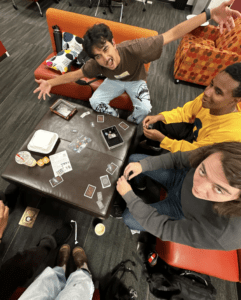
 The Resistance, designed by Don Eskridge and published by Insomniac Games, is a social deduction board game targeted towards teens to adults. While the mechanics are simple and the theme and story do not affect the gameplay, the resulting dynamics can give rise to strategic thinking and meta-reasoning. The primary mechanic that emphasizes the social deduction in this game is the secretive play of a “success” or “failed” card. Since it’s a mystery which players played which cards, the central element of the game lies in deducing which players may have played the failed card.
The Resistance, designed by Don Eskridge and published by Insomniac Games, is a social deduction board game targeted towards teens to adults. While the mechanics are simple and the theme and story do not affect the gameplay, the resulting dynamics can give rise to strategic thinking and meta-reasoning. The primary mechanic that emphasizes the social deduction in this game is the secretive play of a “success” or “failed” card. Since it’s a mystery which players played which cards, the central element of the game lies in deducing which players may have played the failed card.
As with many social deduction games, the players are split into two teams: in this case, the resistance and the spies. The spies know who each other are but the resistance is left in the dark. This game can be played with 5-10 players, with dynamically adjusted numbers of spies and numbers of people who need to be on each mission. In my playtesting, I was only able to play with five people at a time. When they are put on a mission, players play a “success” or “failed” card face down. While anyone who is part of the resistance has no choice but to play a success, the spies have the option to play a failed or a success card. This means that if there is a failed card in a pile, it must be the case that one of the players in that group is a spy. Since the missions require many people to go on the mission, it is necessary for the resistance to deduce which player put the failed card.
In one of the rounds that I played when I was part of the resistance, my friend Nick, who typically isn’t a very good liar, was part of two missions that both failed. While simple, so-called “probabilistic” reasoning might lead one to believe that he was a spy, I felt so confident based on his style of play that he was part of the resistance. Therefore, I deduced that in the failed mission with only Crystal and Nick, Crystal must have been the spy. Additionally, in the mission with three people, Nick, Samantha, and myself, I concluded that Samantha was the spy (since I knew I was resistance and assumed Nick was resistance). By combining the piece of information I believed to be true based on hunches and “vibes” with the evidence of the votes, I was able to deduce who was a spy and who was resistance. If this mechanic were missing–if there weren’t votes in this exact way–this social deduction may look completely different.
One unique element of this game compared to other social deduction games is the lack of elimination. In Mafia and Werewolf, people are killed off every night and during the day. In Secret Hitler, there are two options to kill people towards the end of the game. The Resistance, alternatively, doesn’t feature any elimination. In theory, this promotes inclusion and allows everyone to play equally. In practice, that isn’t always the case.
In a round where Crystal and I were the spies, Crystal never got the chance to play. Through a combination of the first round with Pann and Samantha succeeding, a second round with Pann Samantha and myself failing, and the justified assumption that Nick was resistance (again, not a great liar and didn’t seem like a spy), everyone passively deduced that Crystal was a spy. It was hardly even spoken out loud–she was just ignored. While this game does a good job of excluding formal player elimination, that doesn’t mean that everyone will get their fair share of play.
How could this exclusion be avoided? One possibility is to make it so the same player can’t be on three missions in a row. (This would seem to fit with the theme–you need time to rest between missions!) This way, we would have been forced, or at least strongly encouraged, to include Crystal. Of course, this mechanical change may have detrimental effects on the dynamics of the game and could introduce game-breaking strategies in the name of inclusion. Another avenue would be to play with better liars (sorry Nick no shade).
It might also be true that I played the game poorly in that I didn’t strongly defend Crystal. Perhaps I should have made more of an effort to keep her included. However, for that to be the case, I would have to accuse both Pann and Samantha as being spies, which seemed unlikely. While I tried to float this idea, it was a tough sell and I couldn’t push it too hard because there was no good evidence that both of them were spies. Ultimately, my moves were very limited and I felt constrained. Ultimately it seemed that the spies had too little wiggle room for lying. Secret Hitler does a phenomenal job of solving this problem by introducing randomness which might force a good-guy to take a bad-guy action. If The Resistance incorporated something like this, there would be more uncertainty and Spies would have more ways to lie and deceive. However, since the votes are completely anonymous, this change might introduce too much uncertainty.



